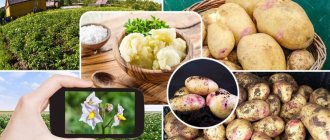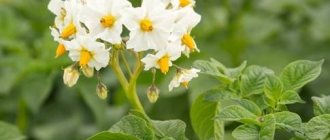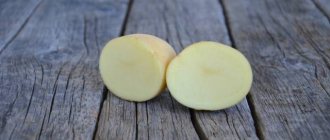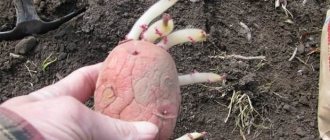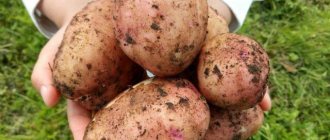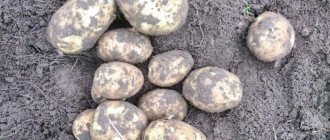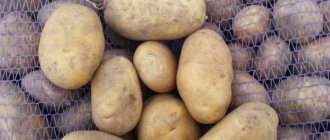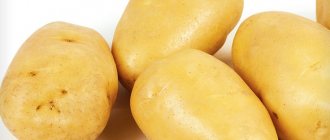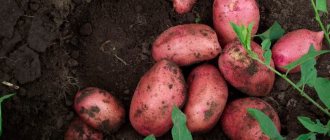Jura potatoes are a table crop variety that was obtained thanks to the efforts of English and Russian breeders. The goal of the creation was to develop a species that is resistant to adverse weather factors and maintains high, stable yields. And the creators completely succeeded. The variety successfully passed all tests and confirmed the declared characteristics. “Isle of Jura” was included in the State Register of Russia in 2007. This potato is recommended to be grown in the central regions, but judging by reviews, it is also successfully cultivated in the northern regions of the country.
The variety has been in the top five for 10 years
Description of the Jura potato variety
Isle of Jura - developed by breeders from Great Britain. It has been in the State Register of the country since 2007; in addition to the foreign company, the domestic originator of the variety, New Potato LLC from the Moscow region, has been named. Medium-sized Jura bushes of intermediate type, with strong, semi-erect stems. Large leaves are dark green with slightly wavy edges. In June, flower stalks grow on individual stems of the Jura variety. The corollas are white and large.
The oval tubers of the Jura potato variety, as seen in the photo, are elongated. The eyes are sparsely located, small, small. The smooth peel is yellow-beige, thin after digging, gradually becoming coarser during storage. Light sprouts are thick and whitish. The pulp is creamy-yellowish, which indicates the presence of a large amount of beta-carotene.
Tubers of the Jura variety for table use belong to the culinary type BC:
- universal;
- moderately mealy;
- the pulp is slightly boiled.
Depending on agricultural cultivation technology and weather conditions, the starch content in mid-early potatoes ranges from 12 to 16%. The numbers correspond to the average indicators for the level of accumulation of the substance on which the boilability of the tuber depends. Tasters gave the variety a taste rating of 4 to 5 points.
Harvesting and storage
It is recommended to collect tubers no earlier than 65 days after sowing. To do this, dig up the bush, remove the potatoes from the hole and put them in a bucket.
The ripeness of the crop is determined by the peel: it must be strong. The collected tubers must be thoroughly dried and transported to a dark room (cellar or basement). Before moving to storage, potatoes should be sorted. Large potatoes are used for food, smaller ones are stored as seed.
It is recommended to store the harvest in wooden pallets, making sure that no moisture gets on it.
Pros and cons of the Jura variety
Potatoes have proven to be high-yielding and hardy in conditions of cool summers and frequent rainfall, characteristic of the areas of the Central region, where the variety is recommended for cultivation. Tubers quickly form and gain weight. The variety begins to be dug 65-80 days after emergence. Over the years of cultivation, gardeners have compiled a list of advantages of Isle of Jura potatoes:
- early production;
- good yield in the group of mid-early varieties;
- high marketability of tubers;
- excellent keeping quality;
- versatility;
- pleasant taste of dishes;
- unpretentiousness to the weather conditions of central Russia;
- resistance to a number of diseases.
If the disadvantages include the specially selected by breeders undemandingness to rather harsh weather conditions, then the disadvantage of this variety is that it is not adapted to droughts. The Isle of Jura is the brainchild of Scottish agronomists, where areas are more likely to suffer from plenty of rain, but not from dry periods.
Pests and diseases
This variety has high natural immunity. Therefore, it is not affected by cancer, scab, golden nematode and blackleg. In the event of a rainy summer, Isle of Jura shoots may become infected with late blight. Therefore, to preserve yields, it is recommended to use preventive spraying of bushes with fungicides.
The most effective of them:
- Ridomil Gold.
- Quadris.
- Home.
The Isle of Jura is affected by the Colorado potato beetle. Therefore, if a pest is present, it is necessary to use insecticides to prevent mass spread.
Tubers can also be damaged by cutworms and wireworms. Therefore, it is necessary to remove weeds in and around the site. The danger to the Isle of Jura is aphids and whiteflies. To combat these pests, you should use Confidor Extra.
Planting and caring for Isle of Jura potatoes
The variety must be planted and grown using standard agricultural technology. Potatoes develop well after last year's planting of any grains, legumes and melons, as well as after cabbage, beets, and carrots.
Selection and preparation of a landing site
For the Isle of Jura potato variety, the plot is prepared in the fall, enriching every square meter with nutrients:
- before plowing, add 6-8 kg of humus or manure;
- 30 g of superphosphate;
- You can add humus before spring cultivation;
- Directly during planting, 130-180 g of wood ash is placed at the bottom of the hole.
Advice! If, according to the long-term forecast, return frosts are possible, high ridges are formed, and seeds are planted in the grooves on the tops.
Preparation of planting material
Jura potato tubers, according to the description of the variety, photos and reviews, form strong light sprouts after special preparation. A month before planting, seed potatoes are lifted from the cellars into the light for germination. The tubers are laid out in 2-3 layers in wooden or plastic boxes and placed in a bright, cool room. The temperature should not rise above + 14-15 °C so that the sprouts do not stretch. After proper vernalization, the shoots reach 0.5-1.2 cm.
Landing rules
In an effort to get a rich harvest of the Jura variety, they adhere to generally accepted rules:
- planting is carried out when the soil at the depth of potato placement warms up to 10-12 °C;
- on structured loams and sandy loams, the hole depth for the mid-early variety is 8-10 cm;
- on heavy clay soils, Jura potatoes are planted at a depth of 5-6 cm;
- optimal placement scheme for a small bush Isle of Jura - 50x60 cm;
- The location of the light sprouts when planting does not affect the potato yield.
Important! For a successful start, tubers of the Jura variety are treated before planting with preparations that stimulate the development of the plant, Zircon, Mival or others.
Watering and fertilizing
Judging by the characteristics of the variety and reviews of Jura potatoes, the moisture-loving crop is regularly watered if there is insufficient rainfall:
- the beginning of watering - in the phase of 13-15 cm of stem height, 2.5-3.5 liters for each plant;
- when buds form, the bushes are watered with 6-7 liters;
- during the period of tuber formation they give 10-12 liters.
Organic fertilizers are not enough for good yield of the Jura variety. Potatoes are fed with complex mineral and organomineral fertilizers:
- "AVA";
- "Kemira";
- "Crystalon";
- "WMD";
- "Bulba" and others.
After the first watering or earlier, foliar feeding is carried out. To treat leaves, prepare a mixture in 10 liters of water:
- 90-110 g urea;
- 150 g of potassium monophosphate;
- 5 g boric acid.
After 2-3 weeks, feed again in the same way, but in a higher concentration - per 5 liters of water.
Loosening and weeding
Potato plantings are regularly looked after. After watering, loosen the soil with light tools without damaging the tubers. Weeds are removed.
Hilling
The characteristics of the Jura potato emphasize that the variety is moisture-loving. Hilling will help create a convenient environment for the tubers to gain weight. Hill up in damp soil, forming ridges around the bush. Sometimes ridges are made at a stem height of 3-5 cm in case of threat of frost. Hilling is carried out 2-3 times until flowering.
Attention! To grow, the bushes are fertilized with a solution of 20 g of urea in a bucket of water before the first hilling. Water 500 ml under the root.
Care
Caring for potatoes of this variety comes down to the following steps:
- weeding;
- loosening;
- hilling;
- watering.
Weeding and loosening
Weeding and loosening can be done simultaneously using a rake. It is advisable to carry out these important manipulations for the culture immediately after precipitation falls. In this case, weeds will be removed easily, since the soil is soft and pliable.
Important! Weeds must be removed throughout the summer.
Hilling
Hilling is carried out at least three times per season. First, this important procedure is carried out when the sprouts have reached a height of 15 cm. Next time it is necessary to hill up the potato bushes after a month. The last time this is done is after about 5 weeks or as needed.
Advantages and disadvantages
- excellent taste properties;
- precocity;
- adaptability to sudden cold weather;
- high safety rate;
- low susceptibility to infections of nightshade crops;
- transportability without mechanical damage;
- good, uniform yields;
- good internal texture;
- unpretentiousness of cultivation.
Minuses:
- not suitable for long-term storage;
- Preventative treatment against pests is important;
- does not like drought;
- there is a risk of late blight.
Landing
Isle of Jura potatoes are planted in open, well-lit areas. The material is first germinated.
Deadlines
In the middle zone, planting work begins in the first days of May. The soil should warm up to 10-11 degrees. In the West Siberian region and the Far East, planting begins in mid-May. The blossoming of birch leaves can serve as a guide.
Crop rotation rules
Potatoes are planted after green manure crops (oats, rye, phacelia). The soil after green manure is cleared of pests and pathogenic fungi.
Good predecessors from garden species are zucchini, pumpkins, cabbage, onions, greens, and carrots.
Soil requirements
For potatoes, select a place with loose, nutritious soil with good permeability of moisture and air. It is not advisable to plant in depleted, sandy soils or compacted clay substrate.
Peat and sand are added to loamy soils. For acidification, dolomite and limestone are used. Sandstones are enriched with compost, rotted humus.
Preparing tubers for planting
3-4 weeks before planting, the tubers are sorted for rejection. Remove material with dents, signs of rot and stains. Lay out the potatoes in 1-2 layers in the light at a temperature of 11-12 degrees. Root vegetables 5-6 cm long are used. Larger tubers can be cut.
For disinfection use:
- garlic infusion;
- 1% potassium permanganate;
- Regent;
- Fitosporin.
Landing technology
Potato bushes are spreading and need sufficient space. Planting pattern: 50 cm between holes, 60-70 cm between rows.
Holes in loams are dug 6-7 cm deep, in sandy soils - 10 cm. A handful of rotted compost, 1 tbsp. l. complex phosphorus-potassium fertilizer, 1-2 tbsp. l. ash.
Reviews from netizens
We bought this variety because this variety is intended for the middle zone. And the name is very beautiful, it seems like this variety is of English selection. The variety has a medium ripening period (80-90 days). This is the fourth variety we planted this year for testing. Before this, I wrote reviews about the early varieties Impala and Zhukovsky early. Unfortunately, another Colette variety fell ill and we had to dig it up earlier than expected; it would not be correct to compare it. The bushes of the Isle of Jura potato variety are of medium height with large dark green leaves. The tubers are elongated oval in shape, the eyes are very small. The peel is yellow and rough, light yellow when cut. From six bushes we collected approximately 1.5 buckets or one large construction bucket. The tubers are mostly large. The harvest is the largest of all varieties planted this year. I think the harvest is very good. Let me remind you that, as with other honeycombs planted this year, there was no one to care for it. They did not water, did not hill up or fertilize. Taking these conditions into account, the result is very good. When cooked, the tubers become crumbly, just like my grandmother used to have in the village. These potatoes taste great, just like the good old days. This potato has good resistance to canker and nematode and moderate susceptibility to late blight. I recommend these potatoes for purchase and planting on your farm.
Characteristics of the variety
Jura potatoes are a frost-resistant variety. It gives a good harvest, even if the summer is cool with frosts down to 0 degrees. He is not afraid of winds or humid air. However, these potatoes cannot grow in arid areas where the summers are hot and sultry.
Isle of Jura Potatoes
Medium early variety. The harvest ripens 70-80 days after the first shoots appear. Conditional yield occurs 2 months after planting. Tubers can be dug up to boil or add to soup and other dishes. At this time, the skin of the tubers is thin, not durable, and tends to peel.
The yield is decent - 250-350 centners are collected per hectare. In this way, Isle of Jura potatoes are similar to the Amur, Arrow, and Hermes varieties. The signal for harvesting is dried tops falling to the ground.
Isle of Jura potatoes, the variety description of which contains information about the mid-early ripening period, blooms approximately a month after the first shoots. Flowers appear unevenly. White flowers are located at the very top of the bushes. The corolla is large and whitish. During flowering, tubers begin to form. After about 7-10 days, flowering stops. After this, emerald berries appear on the tops.
Additional Information. Flowering depends on weather conditions. If they are favorable, the first flowers appear after 3-4 weeks. If there are frosts, flowering may begin later.
Features of the plant:
- ü The bush is semi-erect, powerful, spreading;
- ü Average height – about 40-60 cm;
- ü Plant type is intermediate;
- ü The leaves are large, slightly wavy. Color dark emerald;
- ü Number of leafy stems – from 8 to 11;
- ü The plant is resistant to common diseases: potato cancer, golden nematode, late blight of tubers;
- ü The bush is attacked by Colorado potato beetles; it can become infected with late blight of the tops.
Potato plot
Description of tubers
The shape of ripened tubers is oval, they are slightly oblong and even. Each weight is from 110 to 180 grams. There are large specimens, weighing 200 grams. On one bush, tubers of the same size predominantly ripen. Their number per plant is 8-11. The eyes are small. The peel is dense and elastic. It is easy to clean.
Planting thuja: choice of variety, timing, subsequent care
Characteristics of Jura potatoes indicate that the variety has a yellow, uniform peel color. The pulp is creamy, light yellow in color without spots. This variety of potato belongs to varieties with a high carotene content. It is an immune stimulant and protects the human body from viruses.
In addition to carotene, potatoes contain many vitamins and nutrients. For example, tubers contain B vitamins, ascorbic acid, vitamins A, E, potassium, magnesium, calcium, sulfur, phosphorus, iron, manganese, etc.
Important! Potatoes are a healthy vegetable. It removes toxins, reduces blood pressure, promotes the functioning of the digestive system, helps with insomnia and depression.
The amount of starch is average - 12-16%. Table variety. The taste characteristics are high. The taste is pleasant, rich, buttery, classic potato. The aroma is weak. Universal application. These potatoes are suitable for boiling, baking, frying, making salads, soups, and purees. The variety does not darken for a long time after cleaning. During cooking, it retains its shape and does not become soggy. Potatoes are also used for cosmetic and medicinal purposes. The tubers are used to make refreshing masks that remove age spots and brighten the skin. Potatoes smooth out fine wrinkles. Freshly squeezed potato juice helps fight digestive system problems. It can be used for colds, coughs, and swelling.
The commercial quality of the tubers is high. It is estimated at 90%. Keeping quality is above average. 95% of all potatoes can overwinter in the cellar and last until the spring months without losing their taste. Most often, Jura potatoes are used for food and are not stored for a long time, since the variety is mid-early. It is recommended to leave only seed potatoes until spring.
Agricultural technology
Landing
Potato Alena
The Jura variety can be easily grown by a novice farmer. It does not require care and is easy to plant. However, the Isle of Jura has a number of peculiarities in agricultural technology.
Potatoes are planted in open ground. The area should be sunny; lowlands are not suitable. The land needs to be prepared in the fall. The best place for this variety is an area where perennial grasses, winter crops, legumes, and flax grew. The soil is dug well, plant roots are removed, and organic matter is added. The Jura variety does not like sour, heavy soil. Immediately before planting, the place where the potatoes will grow is dug up again. Peat and sand are added. Planting takes place in May.
Note! It is recommended to plant potatoes after the first leaves appear on the birch tree.
In April, planting material is placed in a bright place, where it is about +12 degrees. Such conditions will help the potatoes to germinate faster. Large Jura potatoes can be cut into small pieces, which are planted as independent tubers. Before planting, the material is treated with manganese or garlic infusion. It is believed that this procedure will disinfect the tubers from pests and also act as a growth stimulator. You can buy special medications in stores.
Planting a crop
The variety is planted using a shovel or equipment, for example, a walk-behind tractor, a tractor. The bushes of the Isle of Jura, although spreading, are not tall. Therefore, the holes are placed at a distance of 40-50 cm. Rows are made every 50-60 cm.
Methods of planting varieties: smooth, ridge. Ridge cultivation is carried out when the soil is heavier. The ridges are made from north to south. Thus, the plantings will be exposed to the sun during the day.
In order for Isle of Jura potatoes to develop normally, the tubers are planted to a depth of 8-10 cm. Ash, onion peels, and complex fertilizer are added to the holes along with the potatoes.
Care
Caring for the crop is simple. Operations include: weeding, loosening, watering, hilling, treatment against pests and as a disease prevention. Jura is a type of potato that does not require additional fertilizing during the growing season if planted in fertilized soil.
Weeding can be combined with loosening the soil. Weeds are removed throughout the summer.
It is best to do this as soon as it has rained. The earth is loosened with a rake and weeds are removed. After rain, this procedure will help avoid the formation of a hard earthen crust.
Watering is rare. If the weather is hot, the potatoes need to be watered once a week. One bucket of water is consumed per bush.
During the season you need to carry out several hillings. The procedure will help saturate the soil with oxygen and remove weeds. The summer resident should carry out the first hilling after the seedlings have stretched to 10-15 cm. The second time this is done after 3-4 weeks. The third time - in a month.
Hilling up potatoes
Important! A good preventative against the Colorado potato beetle on potatoes is an ash solution; the ash can be applied to the tops. If the beetle has already appeared, then various chemicals are sold in stores. It will be effective to collect larvae and the Colorado potato beetle itself.
An infusion of garlic will help fight leaf blight, to which Jura potatoes are susceptible. Every 10 days the bushes are sprayed with Bordeaux mixture, one percent is suitable.
